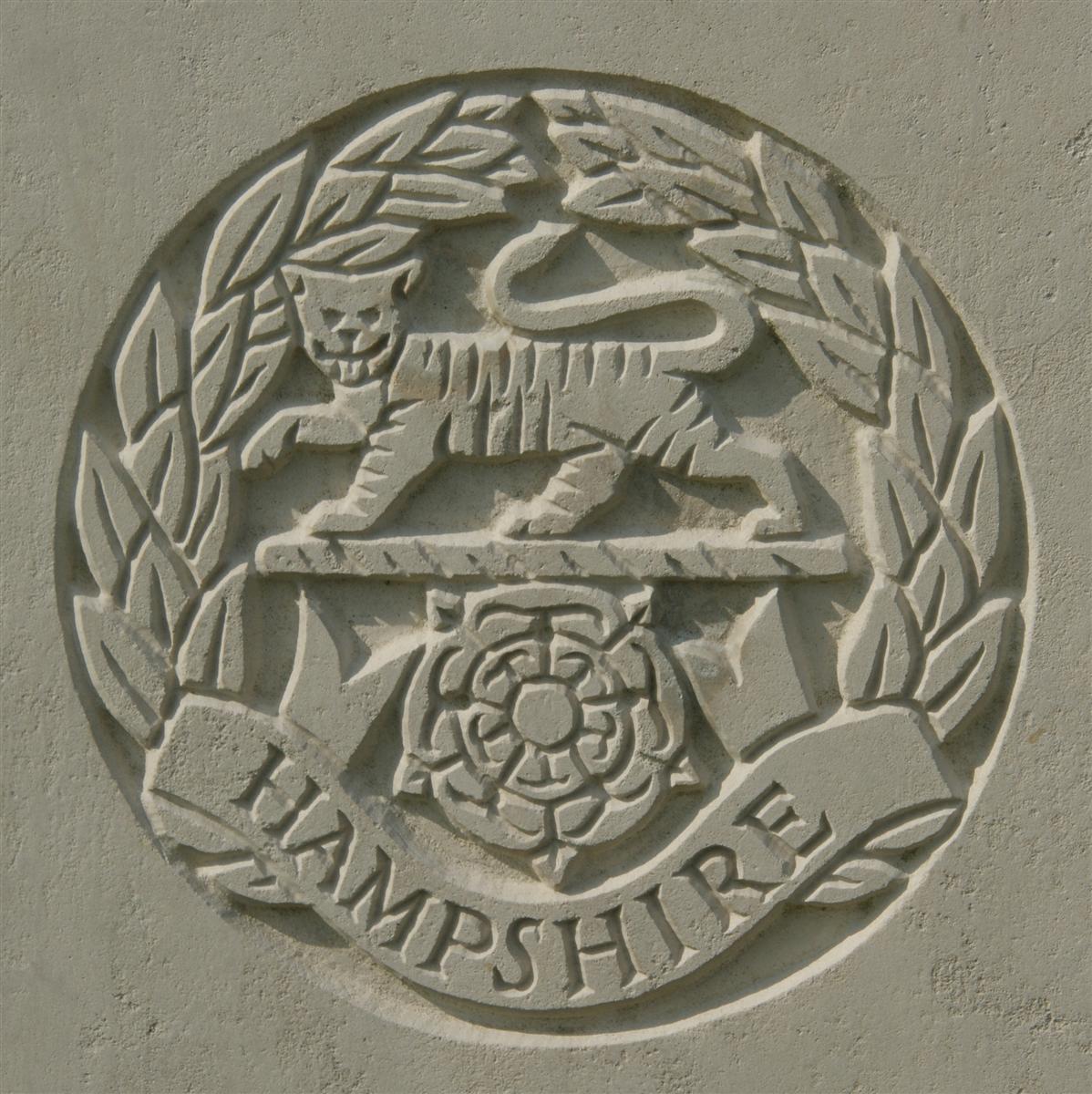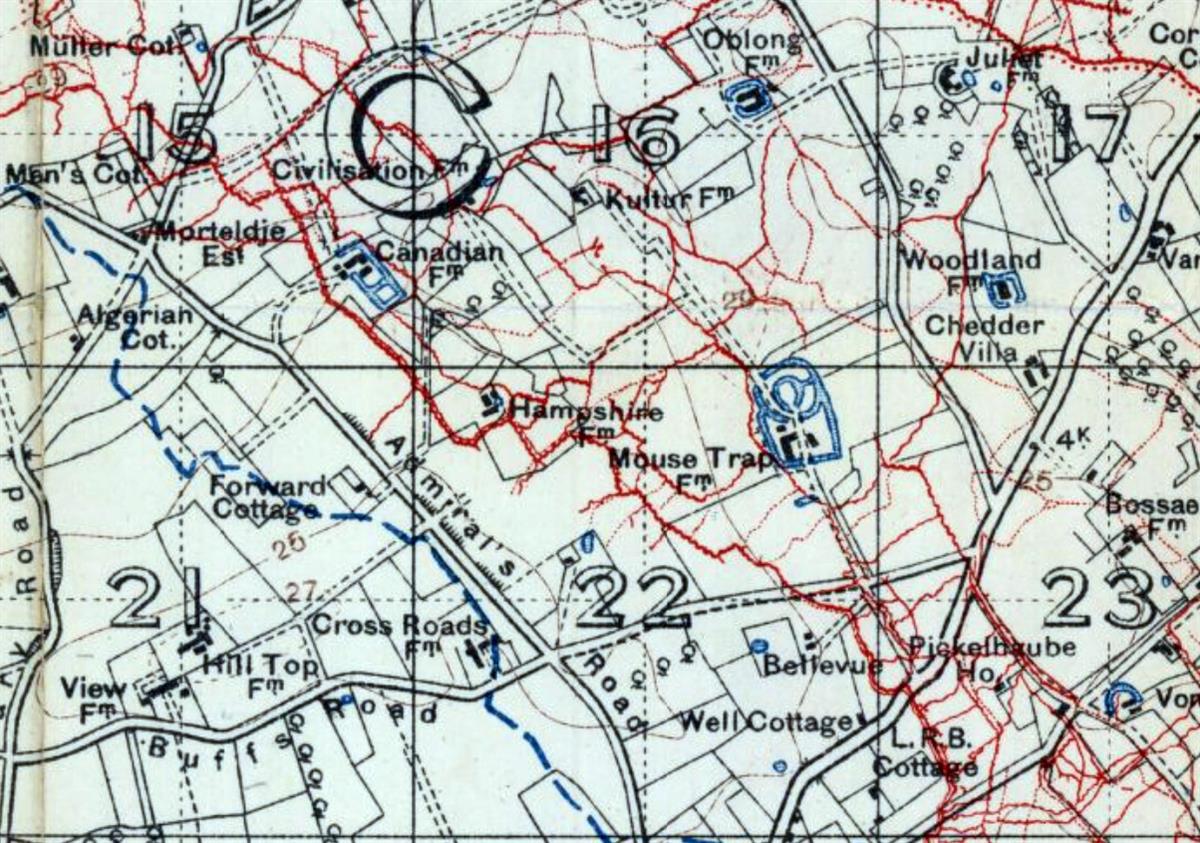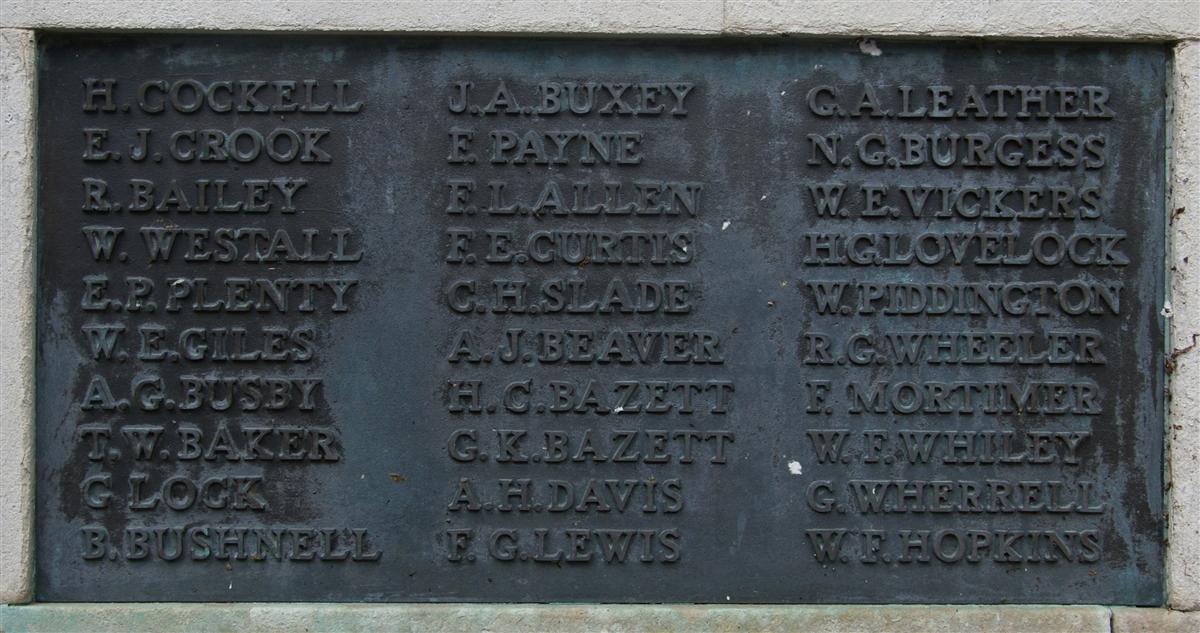Reginald George Wheeler
Private 15293 Reginald George Wheeler, 1st Battalion, Hampshire Regiment
Reginald was born in Colnbrook near Eton (then in Buckinghamshire, now in Berkshire). His parents, Thomas James Wheeler and his wife Clara Annie née Dunn, were originally from Newbury, but had led a fairly peripatetic life: they married in Wiltshire (near Yeovil) before having children in Hillingdon, Middlesex (Beatrice Annie, born 1882) ; Wooburn, Bucks (Percival Leslie, 1885 & Maud Mable, 1887); Colnbrook (Reginald); and the last two in Newbury (Edith Marie, 1897 & Robert Cecil, 1899). They then moved to Woolston near Southampton where they settled at 57 Inkerman Road. Thomas was a foundry worker, probably learning his trade at a Newbury foundry before following work around the country.
Reginald’s schooling would largely have been in Woolston though he may have started in Newbury. After school he was fortunate enough to get an apprenticeship as a letter press printer; a very useful trade that would have seen him through a decent career for the rest of his life had war not intervened. Following his apprenticeship in Woolston he came back to Newbury for a job with the Newbury Weekly News, an organisation that was pleased to give credit to its employees who were serving their country:
Newbury Weekly News, 28 January 1915 – Local War Notes
The “Newbury Weekly News” staff are very proud of the contribution made by the office to the Active and Public Service Roll. The record is as follows:- Pte Hugh Turner, Public School Brigade, Royal Fusiliers; Pte M Hewlett, 17th Lancers; Pte C Thorn, 4th Berks; Lce-Corpl R Bailey, 4th Berks; Driver H Baldwin, Signal Service, Royal Engineers; Pte R Wheeler, Hants Regt; T Holley, Royal Navy; Lce-Cpl Barret, Bedfords; Ashley Turner, C G Jowitt, Ernest West, Home Defence Corps; A Collins and S E Scott, Special Police Reserve. Several others have volunteered their services, but were unable to satisfy military and medical requirements. One member of staff has three sons in the Army, another one son in the Navy and one in the Army. And in spite of the diminution in numbers the “NWN” appears regularly.
Reginald’s path to France is a little confusing; his service number (15293) would appear to have been issued in late 1914, early 1915. In general recruits would receive six months or more training before being drafted to a unit in the field, but Reginald landed in France on 14 April 1915 after only three or four months training. It is also relatively unusual for a man who enlisted in 1914 to be sent to a Regular Army unit, most were sent to one of the so called Kitchener Battalions; the new armies raised from the surge of volunteers following the declaration of war.
However, it may well be that he excelled in his training and, when the need for reinforcements for the 1st Battalion was great – and this was certainly the case by April 1915 – he was picked out as a man who was ready for action.

The regimental badge of the Hampshire Regiment, as used on CWGC headstones. |
The battalion spent the following weeks in the trenches with very little respite, even when they got away from the front line for a couple of days they were shelled in their billet (tents in a field near a French battery – ie within artillery distance of the front).
Night time was a time of activity, the safest time to improve defences, dig deeper trenches, dig more trenches, put up barbed wire entanglements, etc. During the day there might be a chance to catch up on some sleep (though woe betide a sentry caught napping - the maximum penalty was death). So many of the battalion would not have been awakened in the early hours of 13 May:
War Diary, 13 May 1915 – 1st Battalion, Hampshire Regiment
Heavy bombardment began at 4am.
5.50am All fire turned on our second line.
6.5am Heavy shelling of our trenches began again.
During the break a few Germans came on in small parties but half-heartedly. Shelling increased till 6.15 when for ¾ hour it was terrific.
It continued, but in decreasing violence till 2pm when it gradually died away.
D Coy which suffered the most heavily was relieved by C Copy from Support trench.
Casualties: Killed 34 - Wounded 57 - Missing 3
Reginald was among the 34 who died that day; his first month in France was almost over, he never went ‘over the top’ his involvement in the war during two and a half weeks he was with the battalion was to dig defences and act as a target for the enemy artillery. He quite possibly never fired his rifle in anger. He was 21 years old.
The news of his death was announced in the Newbury paper, almost certainly the notice was inserted by his grieving grandmother, Sarah Dunn (née Edmonds):
Newbury Weekly News, 5 June 1915 – Killed in Action
WHEELER – Killed in action on May 13th, at Ypres, Private Reginald George Wheeler, second son of Mr and Mrs T J Wheeler, of “Sarnia,” Woolston, Southampton, and grandson of the late Mr Edmund Dunn, of Stroud Green, Newbury, aged 21 years.
His remains lie in grave IX. A. 17. at the Ypres Reservoir Cemetery.

Map Detail from McMaster University |
This was not their first resting place, after the war a number of battlefield cemetery were closed for one reason or another and the soldiers' remains were ‘concentrated’ into nearby cemeteries. These ‘concentration’ cemeteries also took a large number of bodies recovered from the battlefields. Reginald’s remains and those of a number of his comrades were recovered from map reference C.22.a.78 (see map); most of his comrades had no means of identification, but a fragment of a wooden cross was found in Reginald’s resting place, containing enough information to identify him. This location was pretty much on the German front line during 1916, not far from a strongpoint known as Hampshire Farm - it is amazing that anything remained to identify him.
Reginald was not forgotten, to mark the anniversary of his death another notice appeared in the local paper:
Newbury Weekly News, 18 May 1916 – In Memoriam
In loving remembrance of Private Reginald George Wheeler, 1st Hampshires, second son of Mr and Mrs T J Wheeler, of Woolston, killed in action at Ypres, May 13th, 1915, aged 21 years.
Sadly missed by his Mother, Father, Sisters and Brothers.

Reginald's name on Newbury War Memorial. (right) |
Locally he is remembered on the Newbury Town War Memorial, tablet 9.
He is also remembered in Woolston where a memorial window in St Mark’s Church was installed in memory of the local fallen. A brass plaque below the window records their names, including that of R G Wheeler.
Family
No trace can be found of Reginald’s brothers Percival Leslie and Robert Cecil in the surviving military records; this does not mean they did not serve, there are, for instance many soldiers named Robert Wheeler who served at the front any one of whom might be Robert Cecil, but there is no way to tell.

Find a memorial :
| Died this day: | |
| 15 January 1943 | |
| L C Lawrence | |
| Newbury |

Like this site? Show your appreciation through a donation to a great charity.